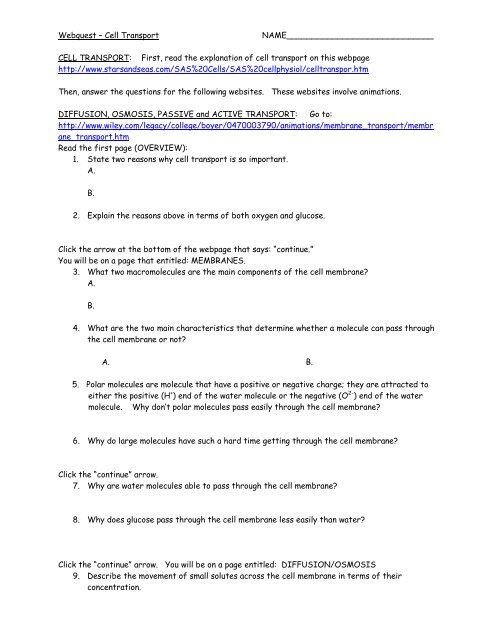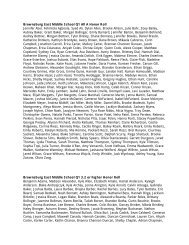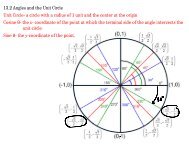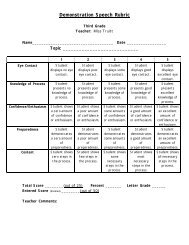Webquest â Cell Transport
Webquest â Cell Transport
Webquest â Cell Transport
You also want an ePaper? Increase the reach of your titles
YUMPU automatically turns print PDFs into web optimized ePapers that Google loves.
<strong>Webquest</strong> – <strong>Cell</strong> <strong>Transport</strong><br />
NAME_____________________________<br />
CELL TRANSPORT: First, read the explanation of cell transport on this webpage<br />
http://www.starsandseas.com/SAS%20<strong>Cell</strong>s/SAS%20cellphysiol/celltranspor.htm<br />
Then, answer the questions for the following websites. These websites involve animations.<br />
DIFFUSION, OSMOSIS, PASSIVE and ACTIVE TRANSPORT: Go to:<br />
http://www.wiley.com/legacy/college/boyer/0470003790/animations/membrane_transport/membr<br />
ane_transport.htm<br />
Read the first page (OVERVIEW):<br />
1. State two reasons why cell transport is so important.<br />
A.<br />
B.<br />
2. Explain the reasons above in terms of both oxygen and glucose.<br />
Click the arrow at the bottom of the webpage that says: “continue.”<br />
You will be on a page that entitled: MEMBRANES.<br />
3. What two macromolecules are the main components of the cell membrane?<br />
A.<br />
B.<br />
4. What are the two main characteristics that determine whether a molecule can pass through<br />
the cell membrane or not?<br />
A. B.<br />
5. Polar molecules are molecule that have a positive or negative charge; they are attracted to<br />
either the positive (H + ) end of the water molecule or the negative (O 2- ) end of the water<br />
molecule. Why don’t polar molecules pass easily through the cell membrane?<br />
6. Why do large molecules have such a hard time getting through the cell membrane?<br />
Click the “continue” arrow.<br />
7. Why are water molecules able to pass through the cell membrane?<br />
8. Why does glucose pass through the cell membrane less easily than water?<br />
Click the “continue” arrow. You will be on a page entitled: DIFFUSION/OSMOSIS<br />
9. Describe the movement of small solutes across the cell membrane in terms of their<br />
concentration.
10. If the high concentration of solutes is outside the cell and the low concentration of solutes<br />
is inside the cell, in what direction will the solutes tend to flow.<br />
11. Do some molecules still go the opposite way (click the rewind button so you can observe<br />
carefully.)<br />
12. When is the flow of molecules in equal to the flow of molecules out?<br />
Click the “continue” arrow to learn about the diffusion of water across a membrane (OSMOSIS).<br />
13. In the model with the two balloons, can the water get across the membrane?<br />
14. Can the sugar (glucose) get across the membrane?<br />
15. If there is a high sugar concentration in one solution, what is the relative concentration of<br />
water (high or low)?<br />
16. If there is a low sugar concentration in the other solution, what is the relative<br />
concentration of water (high or low)?<br />
17. Which way will the water tend to move (in terms of sugar concentration)?<br />
18. Which way will the water tend to move (in terms of water concentration)?<br />
19. What happens to a real cell when it is placed in distilled water?<br />
20. Describe the reason for your answer to number 17.<br />
Click the “continue” arrow.<br />
21. What happened to the two balloons?<br />
22. Why are the two balloons different sizes?<br />
23. What is the “aim” of osmosis?<br />
24. What do you think would happen if you placed a cell in a solution that had a high<br />
concentration of solutes that the cell?<br />
Click the “continue” arrow.<br />
25. What is your answer to the first question? Click on that answer.<br />
26. Explain the reason for the correct answer to the first question.<br />
27. What is your answer to the second question? Click on that answer.<br />
28. Explain the reason for the correct answer to the second question.
Click the “continue” arrow. You will be on the PASSIVE TRANSPORT page.<br />
29. What are the three steps in passive transport?<br />
30. What does “conformational change” mean?<br />
31. What type of macromolecules are membrane transporters?<br />
32. How are passive transporters different from active transporters?<br />
Click the “continue” arrow.<br />
33. Which molecule in the diagram represents the transporter (the orange or the green)?<br />
Click the “continue” arrow.<br />
34. Describe “binding” in terms of the green and red molecules.<br />
Click the “continue” arrow.<br />
35. Describe “conformational change” in terms of the green molecule.<br />
Click the “continue” arrow.<br />
36. Describe the release process.<br />
Click the “continue” arrow.<br />
37. What does it means to say that the function of glucose permease is “reversible”?<br />
Click the “continue” arrow.<br />
38. What do you think is going to happen in the balloon model? Remember that the water can<br />
pass through very easily and quickly. The passage of the sugar is much slower, but it can<br />
pass through.<br />
Click the “continue” arrow.<br />
39. Describe what you observe (in terms of balloon volume, glucose flow, and water flow).<br />
Use the rewind button to observe multiple times.<br />
Click the “continue” arrow.<br />
40. In this model, the transported glucose permease helps to move the glucose through the<br />
membrane more quickly. Think carefully about what you expect to happen and then click<br />
on the answer. Which answer is correct?<br />
Click the “continue” arrow. You will be on the ACTIVE TRANSPORT page.<br />
41. How are active transporters different from passive transporters – give two ways.<br />
A.<br />
B.
42. Which “pump” will you be looking at in this model?<br />
Click the “continue” arrow.<br />
43. Why does the exterior of the cell become positively charged compared to the interior of<br />
the cell in this model?<br />
44. How many Na + ions are pumped out of the cell?<br />
45. How many K + ions are pumped into the cell?<br />
46. Why do the pumps have to act continuously?<br />
Click the “continue” arrow.<br />
47. Describe how the pump works? Include the Na + , K + , and ATP, ADP and P in your<br />
explanation.<br />
Click the “continue” arrow to see how this pump works in a nerve cell.<br />
49. Notice that during the “resting potential”, the outside of the membrane has a positive<br />
charge. What does this resting potential allow for in nerve cells?<br />
Click the “continue” arrow.<br />
50. What happens when the stimulus triggers the nerve cell?<br />
51. What do the Na + -K + ATPase pumps do after the stimulus is triggered?<br />
Click the “continue” arrow.<br />
52. The synapse is the space between two nerve cells (neurons). This is where the electrical<br />
impulse is transferred from one nerve cell to the next via a chemical called a<br />
neurotransmitter. What neurotransmitter is used in this model?<br />
Click the “continue” arrow.<br />
53. What do the Na + -K + ATPase pumps do after the neurotransmitter is released?<br />
Click the “continue” arrow.<br />
54. What happens in the second neuron (nerve cell)?<br />
Click the “continue” arrow to see the process in more detail.<br />
55. In what cell structures is the neurotransmitter found?<br />
56. What does the neurotransmitter cause to happen in the second neuron?<br />
57. What is this an example of?<br />
Click the “continue” arrow.<br />
58. What do the vesicles full of neurotransmitter fuse with?
Click the “continue” arrow.<br />
59. What channels open on the second neuron?<br />
Click the “continue” arrow.<br />
60. What allows the impulse to continue traveling down the second neuron?<br />
Click the “continue” arrow THREE times.<br />
61. Describe the difference in speed between the electrical impulse that travels down the<br />
neurons and the transfer of the impulse by neurotransmitters across the synapse.<br />
EXO and ENDOCYTOSIS<br />
Go to: http://highered.mcgraw-hill.com/olc/dl/120068/bio02.swf<br />
62. What type of substances are often taken in by cells?<br />
63. What does hydrophobic mean?<br />
64. What part of the cell membrane is hydrophobic?<br />
Make sure the TEXT is showing at the bottom of your screen. If not, click “text” on the bottom<br />
right. Then click: PLAY<br />
65. Describe how a single-celled organism might take in food.<br />
66. Describe the differences between the three type of endocytosis<br />
A. Phagocytosis<br />
B. Pinocytosis<br />
C. Receptor mediated endocytosis<br />
67. What is exocytosis?<br />
Use the following websites to REVIEW what you have learned.<br />
http://bcs.whfreeman.com/thelifewire/content/chp05/0502001.html<br />
The upper right hand corner has the numbers 1, 2 and 3. This will take you to different areas<br />
(diffusion, passive transport and active transport). Be sure to view the animations. The<br />
conclusions and quizzes are also useful.<br />
http://www.northland.cc.mn.us/biology/Biology1111/animations/passive1.swf<br />
Be sure to wait for each animation to end before you click “NEXT”.










![8.3 Rational Functions and Their Graphs - [x] Remove frame](https://img.yumpu.com/46677280/1/190x146/83-rational-functions-and-their-graphs-x-remove-frame.jpg?quality=85)






